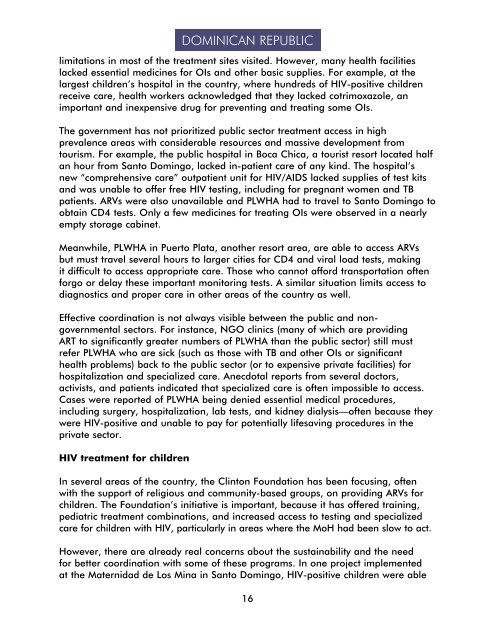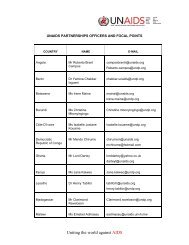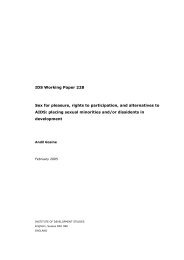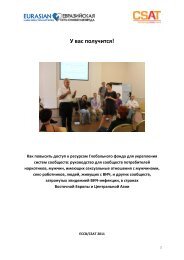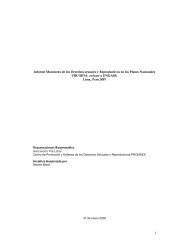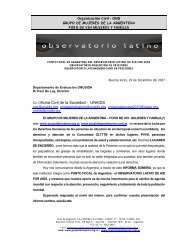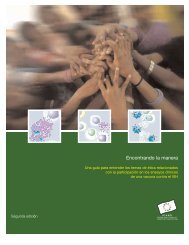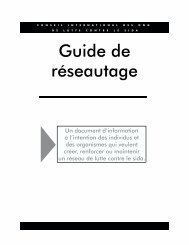Remaining work for asuccessful programBy Eugene Schiff and Felix ReyesOverview of HIV treatment and careOne thousand people have been able to newly access ART over <strong>the</strong> past six monthsin <strong>the</strong> Dominican Republic. According to government statistics, by August 31, <strong>the</strong>rewere now close to 7,300 people receiving ART at approximately 60 sites throughout<strong>the</strong> country. The Global Fund is currently fully subsidizing <strong>the</strong> purchase of all ARVsdistributed at <strong>the</strong>se sites, in coordination with <strong>the</strong> MoH’s HIV/<strong>AIDS</strong> Program.Despite <strong>the</strong>se significant improvements, major gaps and challenges remain.In particular, many public hospitals are still poorly equipped to provide qualitycare for PLWHA. Our field research revealed inefficient logistics systems, stiflingbureaucracy, and a lack of urgency to resolve problems and ensure universal accessto quality care. A recent report by <strong>the</strong> Pan American Health Organization calculatedthat 49.3 percent of all PLWHA needing treatment in <strong>the</strong> Dominican Republic werereceiving antiretroviral medicines at <strong>the</strong> end of 2006. However, <strong>the</strong> same reportestimated 19,190 PLWHA had died of <strong>AIDS</strong> between 2004 and 2006. Relativecoverage may soon get even worse, since even using <strong>the</strong> lowest current estimateof HIV prevalence for <strong>the</strong> country (1.1 percent), as many as 7,000 additional HIVpositivepeople in <strong>the</strong> country now need ART in 2007, and at least a similar numbermay require medicines each additional year in <strong>the</strong> future.Findings in <strong>the</strong> fieldIn preparing this report, <strong>the</strong> authors interviewed more than 25 individuals, includingdoctors, PLWHA, counselors, government officials, NGO staff, and representatives ofinternational agencies. They also visited a dozen clinics and hospitals in Septemberand October 2007 1 .As observed during site visits, ARV medicines, particularly for first-line drugs, aremore widely and consistently available than ever before. Except for two hospitals,which needed but still lacked ARV drugs as of late September 2007 (Boca Chica andSan Pedro de Marcoris), health workers reported ARV drugs were available without1 The facilities visited included Hospital Luis Aybar, Hospital Robert Reid, IDEV, Centro Sanitario,Hospital de San Cristobal, Hospital de Puerto Plata, CEPROSH, Hospital MUSA de San Pedro deMarcoris, Maternidad de San Andres Boca Chica, and Maternidad de Los Mina.15
limitations in most of <strong>the</strong> treatment sites visited. However, many health facilitieslacked essential medicines for OIs and o<strong>the</strong>r basic supplies. For example, at <strong>the</strong>largest children’s hospital in <strong>the</strong> country, where hundreds of HIV-positive childrenreceive care, health workers acknowledged that <strong>the</strong>y lacked cotrimoxazole, animportant and inexpensive drug for preventing and treating some OIs.The government has not prioritized public sector treatment access in highprevalence areas with considerable resources and massive development fromtourism. For example, <strong>the</strong> public hospital in Boca Chica, a tourist resort located halfan hour from Santo Domingo, lacked in-patient care of any kind. The hospital’snew “comprehensive care” outpatient unit for HIV/<strong>AIDS</strong> lacked supplies of test kitsand was unable to offer free HIV testing, including for pregnant women and TBpatients. ARVs were also unavailable and PLWHA had to travel to Santo Domingo toobtain CD4 tests. Only a few medicines for treating OIs were observed in a nearlyempty storage cabinet.Meanwhile, PLWHA in Puerto Plata, ano<strong>the</strong>r resort area, are able to access ARVsbut must travel several hours to larger cities for CD4 and viral load tests, makingit difficult to access appropriate care. Those who cannot afford transportation oftenforgo or delay <strong>the</strong>se important monitoring tests. A similar situation limits access todiagnostics and proper care in o<strong>the</strong>r areas of <strong>the</strong> country as well.Effective coordination is not always visible between <strong>the</strong> public and nongovernmentalsectors. For instance, NGO clinics (many of which are providingART to significantly greater numbers of PLWHA than <strong>the</strong> public sector) still mustrefer PLWHA who are sick (such as those with TB and o<strong>the</strong>r OIs or significan<strong>the</strong>alth problems) back to <strong>the</strong> public sector (or to expensive private facilities) forhospitalization and specialized care. Anecdotal reports from several doctors,activists, and patients indicated that specialized care is often impossible to access.Cases were reported of PLWHA being denied essential medical procedures,including surgery, hospitalization, lab tests, and kidney dialysis—often because <strong>the</strong>ywere HIV-positive and unable to pay for potentially lifesaving procedures in <strong>the</strong>private sector.HIV treatment for childrenDOMINICAN REPUBLICIn several areas of <strong>the</strong> country, <strong>the</strong> Clinton Foundation has been focusing, oftenwith <strong>the</strong> support of religious and community-based groups, on providing ARVs forchildren. The Foundation’s initiative is important, because it has offered training,pediatric treatment combinations, and increased access to testing and specializedcare for children with HIV, particularly in areas where <strong>the</strong> MoH had been slow to act.However, <strong>the</strong>re are already real concerns about <strong>the</strong> sustainability and <strong>the</strong> needfor better coordination with some of <strong>the</strong>se programs. In one project implementedat <strong>the</strong> Maternidad de Los Mina in Santo Domingo, HIV-positive children were able16
- Page 1 and 2: Missing the Target #5:Improving AID
- Page 4 and 5: ArgentinaDr. María Lorena Di Giano
- Page 8 and 9: Executive SummaryAt the G8 meeting
- Page 12: • UN agencies should provide incr
- Page 16 and 17: Price should not be a barrier when
- Page 18 and 19: The Global Fund and UNITAID: The Fu
- Page 20 and 21: The real cost of free treatmentBy a
- Page 24 and 25: DOMINICAN REPUBLICto access rapid t
- Page 26 and 27: DOMINICAN REPUBLICIn Santo Domingo
- Page 28 and 29: ZIMBABWEtreatment, representing 35
- Page 30 and 31: ZIMBABWEAccording to the Medicines
- Page 32 and 33: ZIMBABWEZimbabwe’s application fo
- Page 34 and 35: ZIMBABWENational government• Addr
- Page 36 and 37: RUSSIAMigrantsRussia, with the seco
- Page 38 and 39: a person with HIV will die very qui
- Page 40 and 41: FamiliesIn Kenya, families are the
- Page 42 and 43: INDIA2. Provide pediatric formulati
- Page 44 and 45: Linking nutrition and treatmentBy W
- Page 46 and 47: Most people living with advanced HI
- Page 48 and 49: only available in the capital, Yaou
- Page 50 and 51: ZAMBIAFindings in particular provin
- Page 52 and 53: The DACA for Chadiza District was a
- Page 54 and 55: Many health care workers are inadeq
- Page 56 and 57: DRUG REGISTRATION BARRIERS & LOGJAM
- Page 58 and 59: Country ATV RLPV/rLPV/r(HS)TDFArgen
- Page 60 and 61: development and registration. Likew
- Page 62 and 63: Capacity issues and delays in the W
- Page 64 and 65: Lack of post-approval quality assur
- Page 66 and 67: ARV PROCUREMENT, REGISTRATION,AND S
- Page 68 and 69: ARGENTINAParallel importingRelating
- Page 70 and 71: ARGENTINAAccess to ARVsNo difficult
- Page 72 and 73:
Viral load tests are available, but
- Page 74 and 75:
Cambodiaby Mony PenOnly pharmacists
- Page 76 and 77:
ChinaBy anonymous Missing the Targe
- Page 78 and 79:
CHINAThe current process for regist
- Page 80 and 81:
Dominican RepublicBy Eugene Schiff
- Page 82 and 83:
IndiaBy Abraham KK, Celina D’Cost
- Page 84 and 85:
MalawiBy Lot Nyirenda and Grace Bon
- Page 86 and 87:
MALAWIStock-outsAccording to an ext
- Page 88 and 89:
MoroccoBy Othman MelloukMorocco has
- Page 90 and 91:
Determine the patent status of all
- Page 92 and 93:
MOROCCOThe shortage occurred becaus
- Page 94 and 95:
As of November 2007, the unit cost
- Page 96 and 97:
NIGERIADiagnostic testsDiagnostic t
- Page 98 and 99:
The government’s initial inabilit
- Page 100 and 101:
Increase training and capacity buil
- Page 102 and 103:
treatment practice. The Minster ann
- Page 104 and 105:
Ugandaby Richard Hasunira, Prima Ka
- Page 106 and 107:
UGANDAExtracts from the MoH’s rep
- Page 108 and 109:
ZAMBIAIn gathering this information
- Page 110 and 111:
However, since manufacturing prices
- Page 112 and 113:
105SHORT SUMMARY
- Page 114:
PAKISTANAccess for marginalized gro


